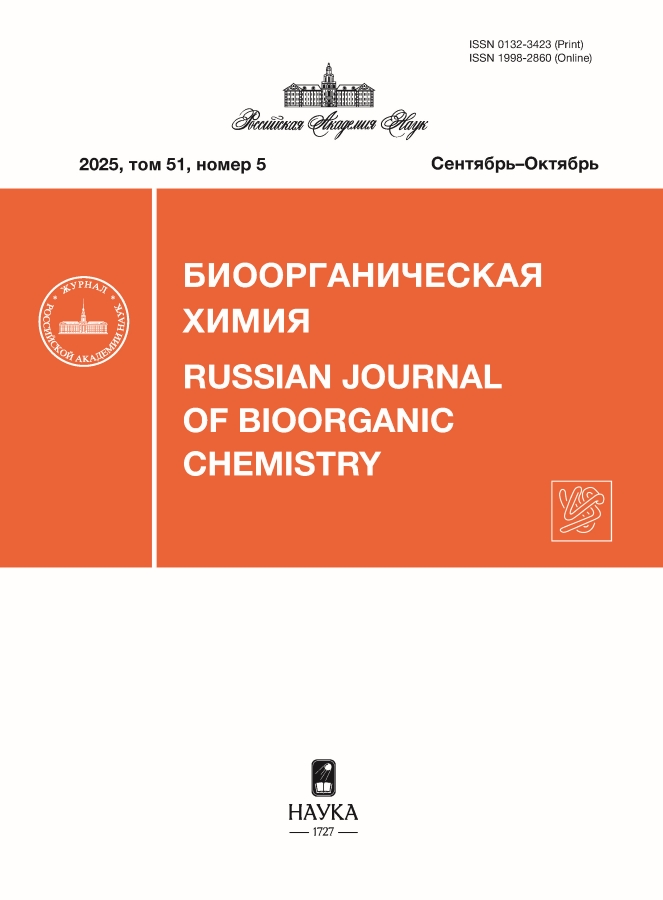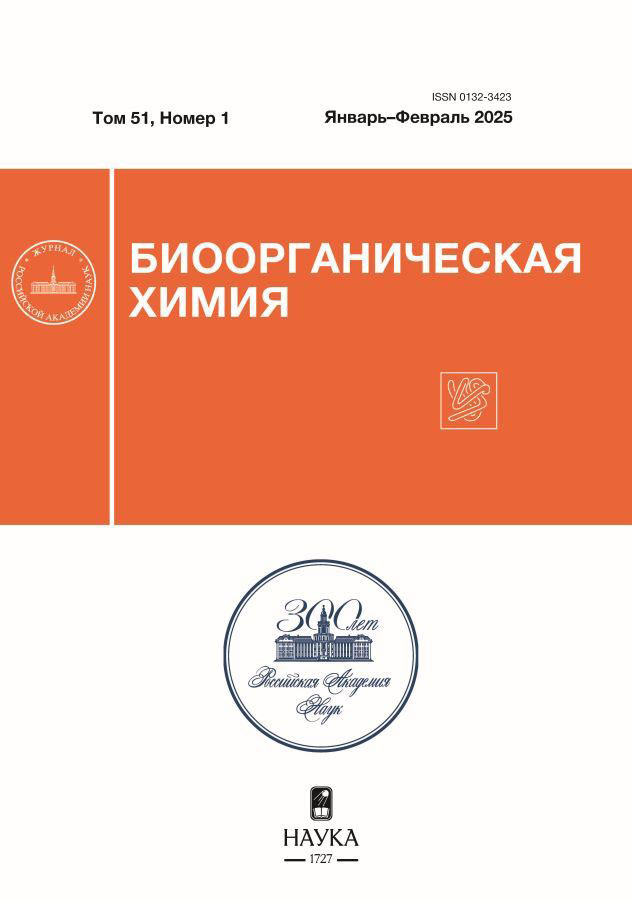Arylidene-imidazolones with three electron-donating substitutions as fluorogenic dyes for lipid droplets of living cells
- Authors: Rudik D.I.1, Gilvanov A.R.1,2, Smirnov A.Y.1,2, Bogdanova Y.A.1,2, Krasnova S.A.1, Baranov M.S.1,2
-
Affiliations:
- Shemyakin–Ovchinnikov Institute of Bioorganic Chemistry RAS
- Pirogov Russian National Research Medical University
- Issue: Vol 51, No 1 (2025)
- Pages: 153-159
- Section: ПИСЬМА РЕДАКТОРУ
- URL: https://clinpractice.ru/0132-3423/article/view/683105
- DOI: https://doi.org/10.31857/S0132342325010145
- EDN: https://elibrary.ru/LYIZOX
- ID: 683105
Cite item
Abstract
A pair of new fluorogenic dyes from the arylidene-imidazolones’ family, containing simultaneously three electron-donating groups in the arylidene fragment, has been obtained. The optical properties of the resulting compounds were studied. It was shown that they are characterized by a noticeable bathochromic shift of absorption and emission maxima, as well as a pronounced variation of the position of the emission maximum depending on the properties of the environment. Using the HeLa Kyoto and Huh 7.5 cell lines as an example, we demonstrated that (Z)-5-(3,5-bis(dimethylamino)-4-(ethylamino)benzylidene)-2,3-dimethyl-3,5-dihydro-4H-imidazol-4-one can be used as a selective fluorogenic dye for fluorescent labeling of lipid droplets, which indicates the potential of this fluorogen for staining these organelles in other living systems.
Full Text
About the authors
D. I. Rudik
Shemyakin–Ovchinnikov Institute of Bioorganic Chemistry RAS
Author for correspondence.
Email: svetlanakr2002@mail.ru
Russian Federation, Moscow
A. R. Gilvanov
Shemyakin–Ovchinnikov Institute of Bioorganic Chemistry RAS; Pirogov Russian National Research Medical University
Email: svetlanakr2002@mail.ru
Russian Federation, Moscow; Moscow
A. Yu. Smirnov
Shemyakin–Ovchinnikov Institute of Bioorganic Chemistry RAS; Pirogov Russian National Research Medical University
Email: svetlanakr2002@mail.ru
Russian Federation, Moscow; Moscow
Yu. A. Bogdanova
Shemyakin–Ovchinnikov Institute of Bioorganic Chemistry RAS; Pirogov Russian National Research Medical University
Email: svetlanakr2002@mail.ru
Russian Federation, Moscow; Moscow
S. A. Krasnova
Shemyakin–Ovchinnikov Institute of Bioorganic Chemistry RAS
Email: svetlanakr2002@mail.ru
Russian Federation, Moscow
M. S. Baranov
Shemyakin–Ovchinnikov Institute of Bioorganic Chemistry RAS; Pirogov Russian National Research Medical University
Email: svetlanakr2002@mail.ru
Russian Federation, Moscow; Moscow
References
- Ermakova Y.G., Bogdanova Y.A., Baleeva N.S., Zaitseva S.O., Guglya E.B., Smirnov A.Yu., Zagudaylova M.B., Baranov M.S. // Dyes Pigm. 2019. V. 170. P. 107550. https://doi.org/10.1016/j.dyepig.2019.107550
- Ermakova Y.G., Sen T., Bogdanova Y.A., Smirnov A.Yu., Baleeva N.S., Krylov A.I., Baranov M.S. // J. Phys. Chem. Lett. 2018. V. 9. P. 1958–1963. https://doi.org/10.1021/acs.jpclett.8b00512
- Krasnova S.A., Bogdanova Y.A., Sokolov A.I., Myasnyanko I.N., Smirnov A.Yu., Baranov M.S. // Russ. J. Bioorg. Chem. 2024. V. 50. P. 251–259. https://doi.org/10.1134/s1068162024010059
- Tauchi-Sato K., Ozeki S., Houjou T., Taguchi R., Fujimoto T. // J. Biol. Chem. 2002. V. 277. P. 44507–44512. https://doi.org/10.1074/jbc.M207712200
- Wolins N.E., Brasaemle D.L., Bickel P.E. // FEBS Lett. 2006. V. 580. P. 5484–5491. https://doi.org/10.1016/j.febslet.2006.08.040
- Farese R.V., Walther T.C. // Cold Spring Harb. Perspect. Biol. 2023. V. 15. Р. a041246. https://doi.org/10.1101/cshperspect.a041246
- Valm A.M., Cohen S., Legant W.R., Melunis J., Hershberg U., Wait E., Cohen A.R., Davidson M.W., Betzig E., Lippincott-Schwartz J. // Nature. 2017. V. 546. P. 162–167. https://doi.org/10.1038/nature22369
- Kaushik S., Cuervo A.M. // Nat. Cell Biol. 2015. V. 17. P. 759–770. https://doi.org/10.1038/ncb3166
- Binns D., Januszewski T., Chen Y., Hill J., Markin V.S., Zhao Y., Gilpin C., Chapman K.D., Anderson R.G.W., Goodman J.M. // J. Cell Biol. 2006. V. 173. P. 719–731. https://doi.org/10.1083/jcb.200511125
- Meng Y., Guo D., Lin L., Zhao H., Xu W., Luo S., Jiang X., Li S., He X., Zhu R., Shi R., Xiao L., Wu Q., He H., Tao J., Jiang H., Wang Z., Yao P., Xu D., Lu Z. // Nat. Metab. 2024. V. 6. P. 1092–1107. https://doi.org/10.1038/s42255-024-01047-2
- Zechner R., Madeo F., Kratky D. // Nat. Rev. Mol. Cell Biol. 2017. V. 18. P. 671–684. https://doi.org/10.1038/nrm.2017.76
- Zadoorian A., Du X., Yang H. // Nat. Rev. Endocrinol. 2023. V. 19. P. 443–459. https://doi.org/10.1038/s41574-023-00845-0
- Krahmer N., Farese R.V., Walther T.C. // EMBO Mol. Med. 2013. V. 5. P. 973–983. https://doi.org/10.1002/emmm.201100671
- Petan T. // Rev. Physiol. Biochem. Pharmacol. 2023. V. 185. P. 53–86. https://doi.org/10.1007/112_2020_51
- Ralhan I., Chang C.-L., Lippincott-Schwartz J., Ioannou M.S. // J. Cell Biol. 2021. V. 220. P. e202102136. https://doi.org/10.1083/jcb.202102136
- Papsdorf K., Miklas J.W., Hosseini A., Cabruja M., Morrow C.S., Savini M., Yu Y., Silva-García C.G., Haseley N.R., Murphy L.M., Yao P., Launoit E., Dixon S.J., Snyder M.P., Wang M.C., Mair W.B., Brunet A. // Nat. Cell Biol. 2023. V. 25. P. 672–684. https://doi.org/10.1038/s41556-023-01136-6
- Chen C., Tachibana S.R., Baleeva N.S., Myasnyanko I.N., Bogdanov A.M., Gavrikov A.S., Mishin A.S., Malyshevskaya K.K., Baranov M.S., Fang C. // Chemistry. 2021. V. 27. P. 8946–8950. https://doi.org/10.1002/chem.202101250
- Li C., Plamont M.-A., Sladitschek H. L., Rodrigues V., Aujard I., Neveu P., Saux T.L., Jullien L., Gautier A. // Chem. Sci. 2017. V. 8. P. 5598–5605. https://doi.org/10.1039/C7SC01364G
- Perfilov M.M., Zaitseva E.R., Smirnov A.Yu., Mikhaylov A.A., Baleeva N.S., Myasnyanko I.N., Mishin A.S., Baranov M.S. // Dyes Pigm. 2022. V. 198. P. 110033. https://doi.org/10.1016/j.dyepig.2021.110033
- Voliani V., Bizzarri R., Nifosì R., Abbruzzetti S., Grandi E., Viappiani C., Beltram F. // J. Phys. Chem. B. 2008. V. 112. P. 10714–10722. https://doi.org/10.1021/jp802419h
- Würth C., Grabolle M., Pauli J., Spieles M., Resch-Genger U. // Nat. Protoc. 2013. V. 8. P. 1535–1550. https://doi.org/10.1038/nprot.2013.087
Supplementary files















